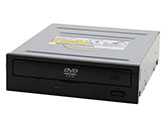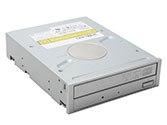Entry Level Buyer’s Guide, July 2005
by Jarred Walton on July 20, 2005 12:05 AM EST- Posted in
- Guides
Storage Recommendations
We've had a couple of articles on the topic of SATA-II recently. The first explained what SATA-II really means, with the basic summary being that it is a "made up" name for 3 Gbps transfer rates and does not require NCQ or any other special features relative to the original SATA. The second was a roundup of SATA-II drives, pitting them against older SATA models. The conclusion of the article was that SATA-II helped in some areas, but there was no decisive winner among the contenders. We invite you to read the article if you want more details, but here, we're basically interested in the best feature level for the best price, with performance being a case of "win some, lose some" regardless of which drive you choose.Budget Hard Drive Recommendation: Hitachi Deskstar 7K80 HDS728080PLA380 80GB SATA-2
Price: $57 shipped (OEM)
Even though SATA-2 is an unofficial spec and doesn't guarantee faster performance, it does win out in several benchmarks and the Hitachi drive is cheaper than any other 80GB SATA HDD. The Hitachi SATA-2 drives also offer NCQ support, though again that can help or hurt performance depending on the application. While some people will want more than the 80GB offered here, most budget users will find the storage to be more than sufficient. If you eventually run out, adding a second hard drive is one of the easiest upgrades that you can make to a PC. Worth mentioning is that not all of the motherboards actually support the faster 3 Gbps transfer rate of SATA-2, but the drives are backwards compatible with 1.5 Gbps data rates, so it's still safe to purchase the newer models, regardless of motherboard.
Upgraded Hard Drive Recommendation: Hitachi Deskstar T7K250 HDT722516DLA380 160GBSATA-2
Price: $87 shipped (OEM)
For our upgraded hard drive, we felt that double the capacity was sufficient. You can get a slightly better cost per GB of storage by moving to the 250GB drives, but few people need that much storage. As with our base recommendation, we ended up settling on the SATA-2 drive from Hitachi. Western Digital makes a standard SATA model that costs $2 less, and Samsung and Seagate have models that are $5 to $10 more, but for now, we're content to go with SATA-2 support at a lower price than competitors offer.
If you want a quieter drive, Samsung is the best choice; the rest of the manufacturers are all pretty similar in noise levels. The best price per GB of storage comes from the Seagate 7200.8 - at least at the time of writing. $119 for 250GB of storage finally breaks the 50 cents per GB mark for SATA storage. Western Digital and Hitachi offer similarly priced models, and the difference between the 160GB Hitachi at 55 cents per GB and the 250GB Seagate at 48 cents per GB may not be enough to get you to fork out the extra $30.
Budget Optical Recommendation: Lite -On 16X DVD-ROM Model SOHD-16P9S
Price: $22 shipped (OEM)
A few people wondered why we would put a DVD+R into a budget system in the last Budget Guide, and the answer is that you really don't need DVD+R/CD-RW capabilities for a budget system. We're saving over $20 by going with a DVD-ROM on our budget setup, but if you have any interest in burning CDs or DVDs, we highly recommend the upgrade to a DVD+R drive. Anyone who doesn't need recording capabilities can get the cheapest DVD-ROM that they can find, but we're requiring DVD support as we've heard that Windows Longhorn will ship on a DVD rather than multiple CDs. The $10 saved by dropping to a CD-ROM isn't worth the hassle of upgrading to DVD support in the future.
Upgraded Optical Recommendation: NEC 16X Silver DVD+/-RW Model ND-3540A
Price: $48 shipped (OEM)
For the rest of you who agree that the backup/archival uses of DVD+R media alone is worth the price of admission, we have the NEC 3540A burner. An update to the 3520A and 3500A, the price of the NEC burners continues to lead all contenders (though by a slim margin). Our recent DVD+R Roundup uncovered issues with reading and writing several types of media with the latest drives, but we're hopeful that BIOS/firmware updates will solve most of the issues. None of the drives were able to obtain a clear victory, and availability of some of the drives (like the BenQ DW1640) is limited. If you can find the BenQ DW1640, it was the only drive that successfully read back every disc that it wrote - though it still couldn't write to every disc type. As another alternative to the NEC drive, the LG GSA-4163 adds DVD-RAM support for a small price increase of $4. Whichever DVD+R you choose, the key is to recognize its strengths and weaknesses in terms of media - paired with the appropriate DVD+/-R, any of these drives will work well.
Optional Equipment: Any 3.5" Floppy Drive
Price: $8 shipped (OEM)
While not required, there are still times when a floppy drive can prove useful. None of these boards will require a floppy to install Windows XP, but if you want to add a second hard drive for RAID support, it will be necessary to have a floppy drive. We haven't verified whether or not the motherboards have Windows flashing utilities for updating the BIOS, but Award BIOSes can be updated using the WinFlash application, and that's the most common BIOS type. We'd almost recommend that you avoid the floppy just so that we can hasten its retirement, but the decision is yours.













57 Comments
View All Comments
bob661 - Wednesday, July 20, 2005 - link
#25Do you remember the cost difference?
Zebo - Wednesday, July 20, 2005 - link
"I once calculated the cost of running a 60W lightbulb 24/7 for a year and it was only about $37 - 526 kWHrs at 7 cents per kWHr. "=====================
Was this after your Dad told you to turn off the lights..he's not made of money? I did the same thing.:)
BTW I calculated X2 4200+ is cheaper than 820D dispite costing $250 more up front using the same formula (although I pay 14 cents per kWHr).
Zebo - Wednesday, July 20, 2005 - link
4/10 BTW which last time I checked was an "F".. as in Failure...as in Fu**ed up.Zebo - Wednesday, July 20, 2005 - link
LOL @ suggesting Dell. They have a 4 reseller rating for a reason ya know. They suck. Add in the fact you must get rebates, must get a "hot deal" to relise any savings you're much better off BYO normally.Zebo - Wednesday, July 20, 2005 - link
Nice to see those back and very good job Jarred.Of course I have issue with 1G of ram for a "value"setup.. Any video card with a one. And all should have LCD these days... simply not that much more, $50, for both more view area in 17" and much much better quality than any POS low end CRT.
KayKay - Wednesday, July 20, 2005 - link
Good Choice on the MSI Neo4-FAbecedaria - Wednesday, July 20, 2005 - link
For your Intel setup, I would think that a 2.4C (either on eBay or retail) would perform better than any of the options you mentioned for considerably less money. And you'd get 800FSB. And you'd get HT. Granted, the legacy socket 478 and AGP are going to limitations long term, but if you were going to go for better performance, you'd want to upgrade your video card and MB anyhow.abc
bob661 - Wednesday, July 20, 2005 - link
#18You were most likely CPU limited with that 6600GT in that system. A 9800 Pro wouldn't be.
bupkus - Wednesday, July 20, 2005 - link
I tried a 6600GT in my old system-- a Barton OC'd to 2.2GHz --and it didn't perform as well as my nephew's 9800 Pro on a Barton w/ a 333 fsb and mem, so I returned it.This Venice seems to perform pretty good without any tweaks. I'm using cheap of-the-shelf PNY 2x512 PC2700 DDR at all default settings. 2T, etc.
SDA - Wednesday, July 20, 2005 - link
>> I still feel like I keep repeating myself from Guide to Guide, but maybe you readers don't notice it as much? :)>>It's a good idea to repeat important points. You'll have no trouble remembering the recommendations you made in the last few guides, but what about readers that just look at the latest guide or forgot what earlier ones said once or twice on one page?
wrt the PSU, these systems will probably eat as much power as a couple incandescent lightbulbs, but that doesn't mean a Fortron or something isn't worth the money for an upgrade. At the very least, a better PSU is pretty much guaranteed to last longer (better elcaps, fans, etc.). Remember, there are some components in rock-bottom generics that will die even if you only draw about ten or twenty watts from the things for their entire lifetimes.
>>Anyway, I don't generally worry much about the mail-in rebate opportunities, as it's basically loaning a company your money at 0% interest for several months.>>
heh.. that's a great way of putting it. Shame that most people won't get it (how many times have you seen someone brag about a large tax refund?).